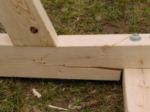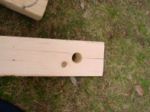Jeckyl and Hyde has now fired for real. We got a total of 6 shots off, before time, light, and some design flaws came into play. It seems that Jeckyl and Hyde's base was not made wide enough to fire stably as a King Arthur-style trebuchet. And so, the machine rocked on every single shot. Not too big a deal at first, but it became one.
We were launching baseballs with 50 pounds of counterweight for all 6 shots. The first shot surprised us all, despite the fact that we knew that there was tremendous potential for power in this machine. It took off like a rocket, at roughly a 15-20 degree angle above horizontal, cleared a 15 foot fence 300 feet away, and landed 345 feet from the front of the machine. Needless to say, we all went nuts. The secondary trigger had gone a tad early, and the release was well after stall and at a flat angle, and yet we still got a terrific first shot. After adjusting the release pin for a (hopefully) earlier release, we took a second shot. This one took off just as fast, at pretty much the same launch angle, but picked up a little more distance, landing at 375 feet.
We were quite happy, and so lengthened the secondary a bit to get the secondary trigger release we wanted, and fired again. The shot took off much smoother, but fell far short of the previous two shots, at roughly 250 feet. Our secondary trigger was now triggering pretty close to optimal, the launch angle was okay, there just wasn't the power there that was in the first two shots. The fourth shot was a bit rougher. The frame rocked significantly, and partially as a result of this, the counterweight bumped the frame on the back swing, digging up the frame a little bit. The shot ended up roughly where the third one did, we didn't bother to measure it as it was clearly in almost the same spot.
Now, the fifth shot was interesting. Unknown to us, one of the bolts holding our adjustable release pin together had come undone. As soon as the secondary trigger released, the release pin opened up and the baseball remained right in its spot in the trough. As the hanger came through its back swing, the unstable frame showed just how unstable it was as the entire frame tipped over backwards. No major damage appeared obvious except for a large crack in the back of the base behind one of the legs in the back of the frame. So, we reset for a final shot, after we had had a good laugh at the misfire. The last shot was much like the 3rd and 4th ones in that the distance was around 250 feet. Again, there was a lot of frame rocking and the counterweight bumping into the frame.
As we were taking Jeckyl and Hyde down, we discovered that the crack in the back of one of the bases was actually really bad: the piece could be pulled out of the frame entirely.

Also, we found that one of our wooden hanger arms had developed a bit of a split around the upper axle hole. This last bit is most likely due to the fact that the wood we used for construction wasn't of the best quality. This is easily fixed by making some new hanger arms, possibly with some metal reinforcements around the axles.

The plan for fixing the unstable base at this point is to bolt on some longer pieces to the front and possibly the back of the frame bases, this should keep the frame from rocking.
After analyzing the video footage, we have determined that our projectile release on every shot was occurring well after the arm stalled, meaning that some energy was not available to launching the baseball. This was occurring on all the shots, though, including the two 300-footers. Our sling had been really long, we will shorten it a bit when we go to fire again. Still, we were attaining an estimated 100 mph launch speed today.
Here is a summary of the 6 shots from today. All were with 50 pounds of counterweight and a standard 5 ounce baseball.
| Shot # | Distance (Feet) | Notes |
| 1 | 345 | Low launch angle. |
| 2 | 375 | Low launch angle. |
| 3 | 250 | Decent launch angle, release well after stall. |
| 4 | ~250 | Decent launch angle, counterweight bumped frame. |
| 5 | 0 | MISFIRE! Frame flipped over. |
| 6 | ~250 | Decent launch angle, counterweight bumped frame. |









